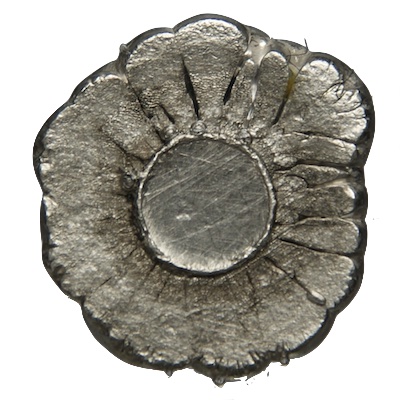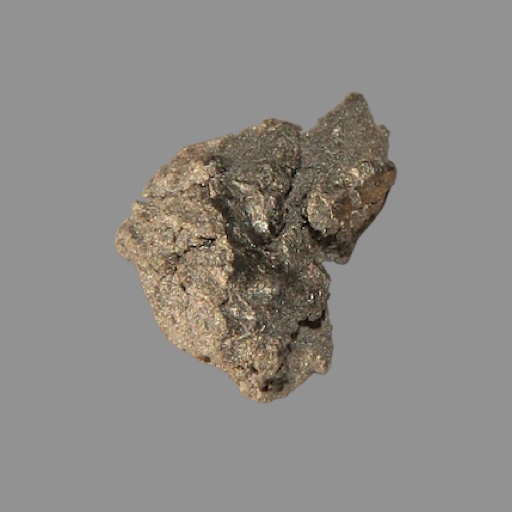Periodic Table Element Comparison: Compare Elements - Nickel vs Zirconium
Compare Nickel and Zirconium
Compare Nickel and Zirconium on the basis of their properties, attributes and periodic table facts. Compare elements on more than 90 properties. All the elements of similar categories show a lot of similarities and differences in their chemical, atomic, physical properties and uses. These similarities and dissimilarities should be known while we study periodic table elements. You can study the detailed comparison between Nickel vs Zirconium with most reliable information about their properties, attributes, facts, uses etc. You can compare Ni vs Zr on more than 90 properties like electronegativity , oxidation state, atomic shells, orbital structure, Electronaffinity, physical states, electrical conductivity and many more.
Facts
| Name | Nickel | Zirconium |
| Atomic Number | 28 | 40 |
| Atomic Symbol | Ni | Zr |
| Atomic Weight | 58.6934 | 91.224 |
| Phase at STP | Solid | Solid |
| Color | Gray | Silver |
| Metallic Classification | Transition Metal | Transition Metal |
| Group in Periodic Table | group 10 | group 4 |
| Group Name | nickel family | titanium family |
| Period in Periodic Table | period 4 | period 5 |
| Block in Periodic Table | d -block | d -block |
| Electronic Configuration | [Ar] 3d8 4s2 | [Kr] 4d2 5s2 |
| Electronic Shell Structure (Electrons per shell) | 2, 8, 16, 2 | 2, 8, 18, 10, 2 |
| Melting Point | 1728 K | 2128 K |
| Boiling Point | 3186 K | 4682 K |
| CAS Number | CAS7440-02-0 | CAS7440-67-7 |
| Neighborhood Elements | Neighborhood Elements of Nickel | Neighborhood Elements of Zirconium |
History
| Name | Nickel | Zirconium |
| History | The element Nickel was discovered by F. Cronstedt in year 1751 in Sweden. Nickel derived its name from Swedish kopparnickel, containing the German word Nickel, 'goblin'. | The element Zirconium was discovered by H. Klaproth in year 1789 in Germany. Zirconium derived its name from Persian Zargun, 'gold-colored'; German Zirkoon, 'jargoon'. |
| Discovery | F. Cronstedt (1751) | H. Klaproth (1789) |
| Isolated | F. Cronstedt (1751) | J. Berzelius (1824) |
Presence: Abundance in Nature and Around Us
Parts per billion (ppb) by weight / by atoms (1ppb =10^-7 %)
| Name | Nickel | Zirconium |
| Abundance in Universe | 60000 / 1000 | 50 / 0.7 |
| Abundance in Sun | 80000 / 2000 | 40 / 0.5 |
| Abundance in Meteorites | 13000000 / 4400000 | 6700 / 1600 |
| Abundance in Earth's Crust | 90000 / 32000 | 130000 / 30000 |
| Abundance in Oceans | 2 / 0.21 | 0.026 / 0.0018 |
| Abundance in Humans | 100 / 11 | 50 / 3 |
Crystal Structure and Atomic Structure
| Name | Nickel | Zirconium |
| Atomic Volume | 6.5888 cm3/mol | 14.011 cm3/mol |
| Atomic Radius | 149 pm | 206 pm |
| Covalent Radius | 121 pm | 148 pm |
| Van der Waals Radius | 163 pm | - |
| Atomic Spectrum - Spectral Lines | ||
| Emission Spectrum |  |  |
| Absorption Spectrum |  |  |
| Lattice Constant | 352.4, 352.4, 352.4 pm | 323.2, 323.2, 514.7 pm |
| Lattice Angle | π/2, π/2, π/2 | π/2, π/2, 2 π/3 |
| Space Group Name | Fm_ 3m | P63/mmc |
| Space Group Number | 225 | 194 |
| Crystal Structure | Face Centered Cubic 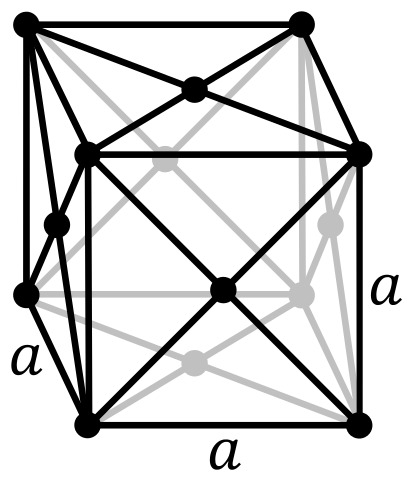 | Simple Hexagonal 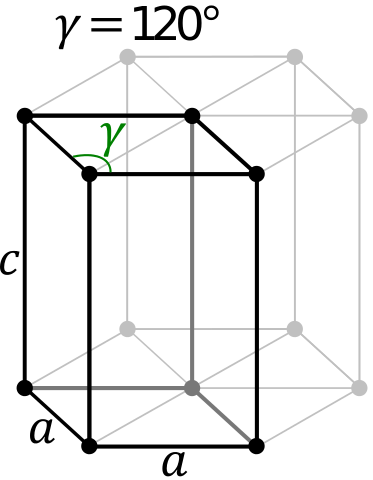 |
Atomic and Orbital Properties
| Name | Nickel | Zirconium |
| Atomic Number | 28 | 40 |
| Number of Electrons (with no charge) | 28 | 40 |
| Number of Protons | 28 | 40 |
| Mass Number | 58.6934 | 91.224 |
| Number of Neutrons | 31 | 51 |
| Shell structure (Electrons per energy level) | 2, 8, 16, 2 | 2, 8, 18, 10, 2 |
| Electron Configuration | [Ar] 3d8 4s2 | [Kr] 4d2 5s2 |
| Valence Electrons | 3d8 4s2 | 4d2 5s2 |
| Oxidation State | 2 | 4 |
| Atomic Term Symbol (Quantum Numbers) | 3F4 | 3F2 |
| Shell structure | 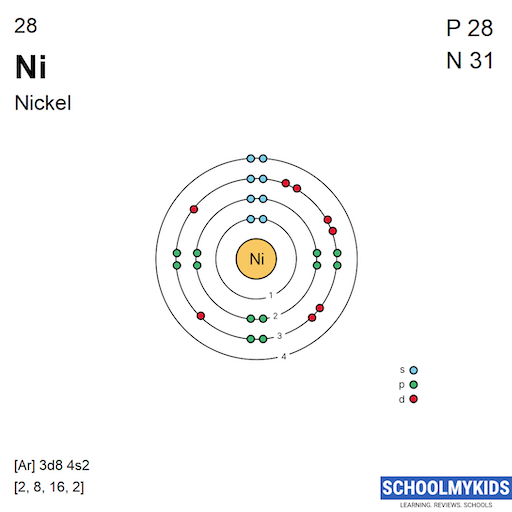 | 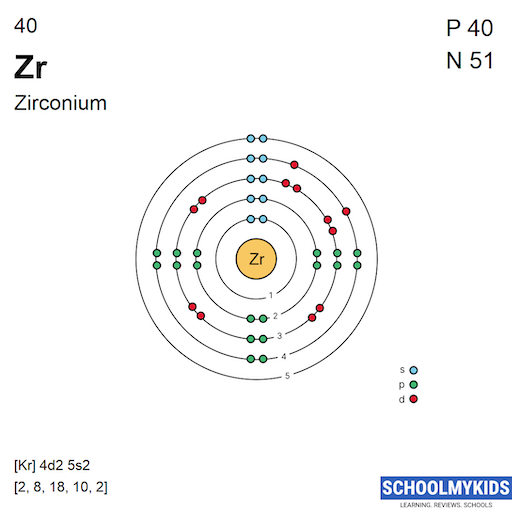 |
Isotopes and Nuclear Properties
Nickel has 5 stable naturally occuring isotopes while Zirconium has 4 stable naturally occuring isotopes.
| Name | Nickel | Zirconium |
| Known Isotopes | 48Ni, 49Ni, 50Ni, 51Ni, 52Ni, 53Ni, 54Ni, 55Ni, 56Ni, 57Ni, 58Ni, 59Ni, 60Ni, 61Ni, 62Ni, 63Ni, 64Ni, 65Ni, 66Ni, 67Ni, 68Ni, 69Ni, 70Ni, 71Ni, 72Ni, 73Ni, 74Ni, 75Ni, 76Ni, 77Ni, 78Ni | 78Zr, 79Zr, 80Zr, 81Zr, 82Zr, 83Zr, 84Zr, 85Zr, 86Zr, 87Zr, 88Zr, 89Zr, 90Zr, 91Zr, 92Zr, 93Zr, 94Zr, 95Zr, 96Zr, 97Zr, 98Zr, 99Zr, 100Zr, 101Zr, 102Zr, 103Zr, 104Zr, 105Zr, 106Zr, 107Zr, 108Zr, 109Zr, 110Zr |
| Stable Isotopes | Naturally occurring stable isotopes: 58Ni, 60Ni, 61Ni, 62Ni, 64Ni | Naturally occurring stable isotopes: 90Zr, 91Zr, 92Zr, 94Zr |
| Neutron Cross Section | 37.2 | 0.184 |
| Neutron Mass Absorption | 0.0026 | 0.00066 |
Chemical Properties: Ionization Energies and electron affinity
| Name | Nickel | Zirconium |
| Valence or Valency | 2 | 4 |
| Electronegativity | 1.91 Pauling Scale | 1.33 Pauling Scale |
| Electron Affinity | 112 kJ/mol | 41.1 kJ/mol |
| Ionization Energies | 1st: 737.1 kJ/mol 2nd: 1753 kJ/mol 3rd: 3395 kJ/mol 4th: 5300 kJ/mol 5th: 7339 kJ/mol 6th: 10400 kJ/mol 7th: 12800 kJ/mol 8th: 15600 kJ/mol 9th: 18600 kJ/mol 10th: 21670 kJ/mol 11th: 30970 kJ/mol 12th: 34000 kJ/mol 13th: 37100 kJ/mol 14th: 41500 kJ/mol 15th: 44800 kJ/mol 16th: 48100 kJ/mol 17th: 55101 kJ/mol 18th: 58570 kJ/mol 19th: 148700 kJ/mol 20th: 159000 kJ/mol 21st: 169400 kJ/mol 22nd: 182700 kJ/mol 23rd: 194000 kJ/mol 24th: 205600 kJ/mol 25th: 221400 kJ/mol 26th: 231490 kJ/mol 27th: 992718 kJ/mol 28th: 1039668 kJ/mol | 1st: 640.1 kJ/mol 2nd: 1270 kJ/mol 3rd: 2218 kJ/mol 4th: 3313 kJ/mol 5th: 7752 kJ/mol 6th: 9500 kJ/mol |
Physical Properties
| Name | Nickel | Zirconium |
| Density | 8.908 g/cm3 | 6.511 g/cm3 |
| Molar Volume | 6.5888 cm3/mol | 14.011 cm3/mol |
Elastic Properties | ||
| Young Modulus | 200 | 68 |
| Shear Modulus | 76 GPa | 33 GPa |
| Bulk Modulus | 180 GPa | - |
| Poisson Ratio | 0.31 | 0.34 |
Hardness - Tests to Measure of Hardness of Element | ||
| Mohs Hardness | 4 MPa | 5 MPa |
| Vickers Hardness | 638 MPa | 903 MPa |
| Brinell Hardness | 700 MPa | 650 MPa |
Electrical Properties | ||
| Electrical Conductivity | 14000000 S/m | 2400000 S/m |
| Resistivity | 7e-8 m Ω | 4.2e-7 m Ω |
| Superconducting Point | - | 0.61 |
Heat and Conduction Properties | ||
| Thermal Conductivity | 91 W/(m K) | 23 W/(m K) |
| Thermal Expansion | 0.0000134 /K | 0.0000057 /K |
Magnetic Properties | ||
| Magnetic Type | Ferromagnetic | Paramagnetic |
| Curie Point | 631 K | - |
| Mass Magnetic Susceptibility | - | 1.68e-8 m3/kg |
| Molar Magnetic Susceptibility | - | 1.53e-9 m3/mol |
| Volume Magnetic Susceptibility | - | 0.000109 |
Optical Properties | ||
| Refractive Index | - | - |
Acoustic Properties | ||
| Speed of Sound | 4970 m/s | 3800 m/s |
Thermal Properties - Enthalpies and thermodynamics
| Name | Nickel | Zirconium |
| Melting Point | 1728 K | 2128 K |
| Boiling Point | 3186 K | 4682 K |
| Critical Temperature | - | - |
| Superconducting Point | - | 0.61 |
Enthalpies | ||
| Heat of Fusion | 17.2 kJ/mol | 21 kJ/mol |
| Heat of Vaporization | 378 kJ/mol | 580 kJ/mol |
| Heat of Combustion | - | - |
Regulatory and Health - Health and Safety Parameters and Guidelines
| Name | Nickel | Zirconium |
| CAS Number | CAS7440-02-0 | CAS7440-67-7 |
| RTECS Number | RTECSQR5950000 | - |
| DOT Hazard Class | 4.1 | 4.2 |
| DOT Numbers | 3089 | 2008 |
| EU Number | - | - |
| NFPA Fire Rating | 4 | 1 |
| NFPA Health Rating | 2 | 1 |
| NFPA Reactivity Rating | 1 | 0 |
| NFPA Hazards | - | - |
| AutoIgnition Point | - | - |
| Flashpoint | - | - |

